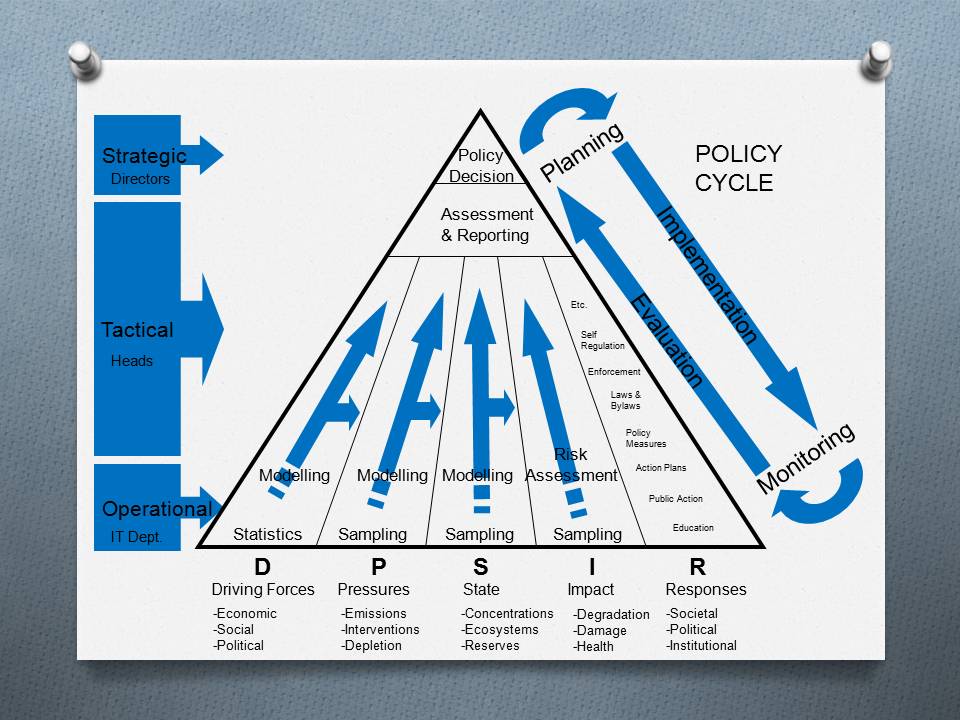Environmental Policy Cycle
The (environmental) policy cycle is an instance of W. Deming's PDCA cycle in (environmental) policy. Deming's cycle consists of 4 phases: (Plan, Do, Check, Act), which should be should be repeated again and again for continuous improvement. In (environmental) policy this typically is every 4 years.
Policy Planning ('Plan')
Policy planning starts off with a proper information management and -provision concerning societal problems and needs. Economic-, Environmental, and Health aspects should be identified, quantified and weighed. In earlier days this was done in the Ivory Towers of scientists, lobbyists, politicians and policy makers. Nowadays we attribute great value to transparency and justification. Moreover, policies now are made by policy makers alone, but public participation is the standard. New policy instruments such as covenants, co-makership, joint implementation, tolerated exceedance of standards (provided they are compensated elsewhere) demand a much higher degree of justification than ever.
Policy Implementation ('Do')
Once policies have been developed and established, lower level governments and target groups need to adapt their policies and business strategies and processes to the new demands and limits. Environmental Action Programs and -Plans need to be developed with cost-efficiency in mind, and approved in consensus and with participation of all stakeholders. Feasibility studies, economic studies and benchmarks may contribute to actually reaching the set targets.
Policy Monitoring ('Check')
 Nowadays policies are monitored by means of specifically targeted statistics and indicators. Indicators are highly aggregated statistics, which are aggregated to the exact same level as the voicing of the policies. Therefore the communicate on the same level, especially so when the indicators are coupled to the policy targets. This then, makes indicators the instrument of choice for monitoring implementation and the degree success of the (environmental- or sustainability) policies.
Nowadays policies are monitored by means of specifically targeted statistics and indicators. Indicators are highly aggregated statistics, which are aggregated to the exact same level as the voicing of the policies. Therefore the communicate on the same level, especially so when the indicators are coupled to the policy targets. This then, makes indicators the instrument of choice for monitoring implementation and the degree success of the (environmental- or sustainability) policies.
These indicators are usually characterized within the DPSIR causality framework (OECD) or similar frameworks. The integrity and quality of the indicators can be assessed and communicated by adopting the NUSAP principles.
Various organizations are developing a plethora of indicators for monitoring their own policy targets. These indicators, however similar in shape, form or naming, are seldom inter-exchangeable, as each and every indicator serves a specific purpose and a specific policy. This makes the development, management and interpretation of indicators into a highly specialized expertise. It also makes the uninformed use of indicators into a risky affair.
This is why we were asked by Eurostat, to scrutinize all European level environmental indicators in use with various supranational authorities (Eurostat, EEA, JRC, OECD and UN/ECE). All indicators were classified, analyzed, and described by means of relevant metadata. Pertinent recommendations were made pertaining to interpretation of, collaboration in, harmonizing of, enhancing quality and efficiency of, and economizing the production of EU-wide indicators.
Environmental reports have grown from simple qualitative enumerations to statistics and indicators based integrated assessments of cause and intensity of environmental pressures, environmental quality, and societal efforts to prevent, improve, and mitigate these.
Information management becomes exceedingly important with the increase in periodic production of indicators and environmental assessments:
- Solid information must be collected, and processed in an economically sound way
- Quality assessment and quality control become increasingly important
- New policy topics emerge, and need to be studied and reported in a cost-efficient, yet adequately effective way
- Available budgets become an increasingly prominent factor
Policy Evaluation ('Act')
Evaluation ex ante
Even before policies are implemented, the efficiency of the policy measures will be questioned and evaluation ex ante may provide insight as to the expected outcomes. The expected positive en negative effects of these measures can be identified, quantified or modeled and weighed against each other.
Evaluation ex post
Adopted policies is implemented and enforced by means of policy actions, legislation, voluntary implementation, compulsory implementation, research, societal actions, etcetera. At some stage the question will emerge as to what we have accomplished with these measures. Or: what "mark can we give this policy". All aspects if the implementation and effects of these policies will be examined, weighed, and added up.
Evaluation ex durante
Interim evaluation is being executed at those moments that certain milestones of the policy implementation are (or should have been) reached, or when certain factors that may influence the outcomes have changed, with a go/no go decision typically following the findings of the evaluation.

